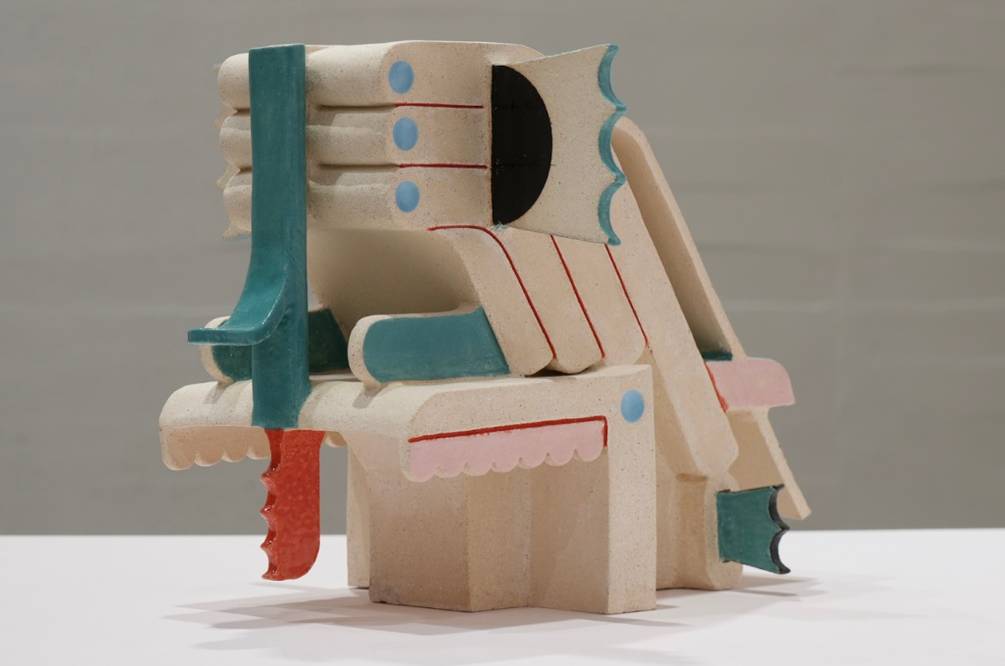
Francisco Muñoz
Falso espiritual
Exhibition
-> Apr 20 – Jun 15
Galería RGR
RGR Gallery presents False Spiritual, an individual exhibition by artist Francisco Muñoz (Tlaxcala, Mexico, 1986). This exhibition, curated by Paola Santos Coy (Mexico City, 1974), makes an analogy between the environment of a temple and the space of exhibition, exploring contemporary spirituality through paintings and sculptures that play with geometry and that make use of diverse cultural references, fusing elements of industrial design, modern Mexican art and pre-Hispanic art, with other cultures such as Japanese. In this series, the use of color and symbols from archaeological murals as inspiration stands out.
On the other hand, the work of Francisco Muñoz explores the ritual function of objects and the way in which they are presented in museum spaces, inviting the viewer to reflect on the meaning and value of the images, focusing on how we perceive art and symbols in relation to their historical and social context, thus questioning the fragility of their meaning.
False spiritual
False spiritual creates an environment that appeals to the idea of a temple within the exhibition space. Through geometric compositions and fields of color, this new series of paintings and sculptures by Francisco Muñoz delves into that which constitutes the aura of things – particularly forms– in relation to the notion of spirituality in the contemporary world.
This ensemble of works is a continuation of Muñoz's research on the dislocation of formal elements and resources collected from diverse artistic manifestations throughout history, as well as from different cultures. In order to create something new, he draws references from specific moments of Mexican modern architecture and sculpture, from pre-Hispanic mural painting, from archaeological objects of the Mesoamerican world, as well as from contexts as distant as the Japanese. In his works, evidence of these sources coexists with more elusive associations.
His interest in the use of color, symbolism and figures in the murals of archaeological sites such as Cacaxtla, in Tlaxcala, Teotihuacan, northeast of Mexico City, and Tajin, in Veracruz, becomes patent in his application of solid fields of color, which bring the paintings closer to a graphic lineage than a pictorial one. While the sculptures are based on hand drawings from the artist’s notebook that, before being manually modeled by means of plate construction, appear as impossible shapes, plagued by references from zoomorphic pre-Hispanic figures, modern monumental sculpture and industrial design. To contemplate these pre-Hispanic murals is necessarily to experience something incomplete, something that only partially appears. Francisco Muñoz calls this strategy "mobilizing fragments of archaeological remains", in order to explore their shapes and surfaces. In each series he experiments with a different color palette, dealing with chromatic combinations as a sort of transmutation of forms.
The way in which we relate to a work of art or to the representation of a symbol depends, to a great extent, on how it is displayed. Ideas of the sacred or the national, for example, arise depending on particular historical moments and contexts. The value of images or objects linked to these ideas is not intrinsic, rather, it is constructed on the basis of a collectivity’s common ground. There is a theatricality with which some of the displays at the National
Museum of Anthropology are curated, for example, combining original pre-Hispanic pieces with reproductions (for conservation reasons). This mise en scène seeks to recreate sacred environments or rituals of the past. This is of particular interest to Muñoz when, through hispractice, he interrogates about the social and ritual function of objects.
With False spiritual Francisco Muñoz places us at the center of a question about the fragility of the effects produced by artworks. His artistic practice can be understood as a kind of pollination that, by taking and using elements from multiple places and moments, manages to mobilize the weight of history and to introduce more questions. Where do forms dwell?
— Paola Santos Coy